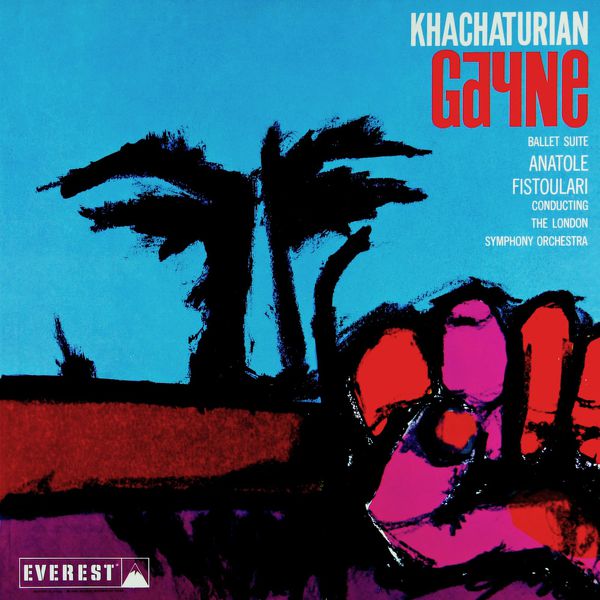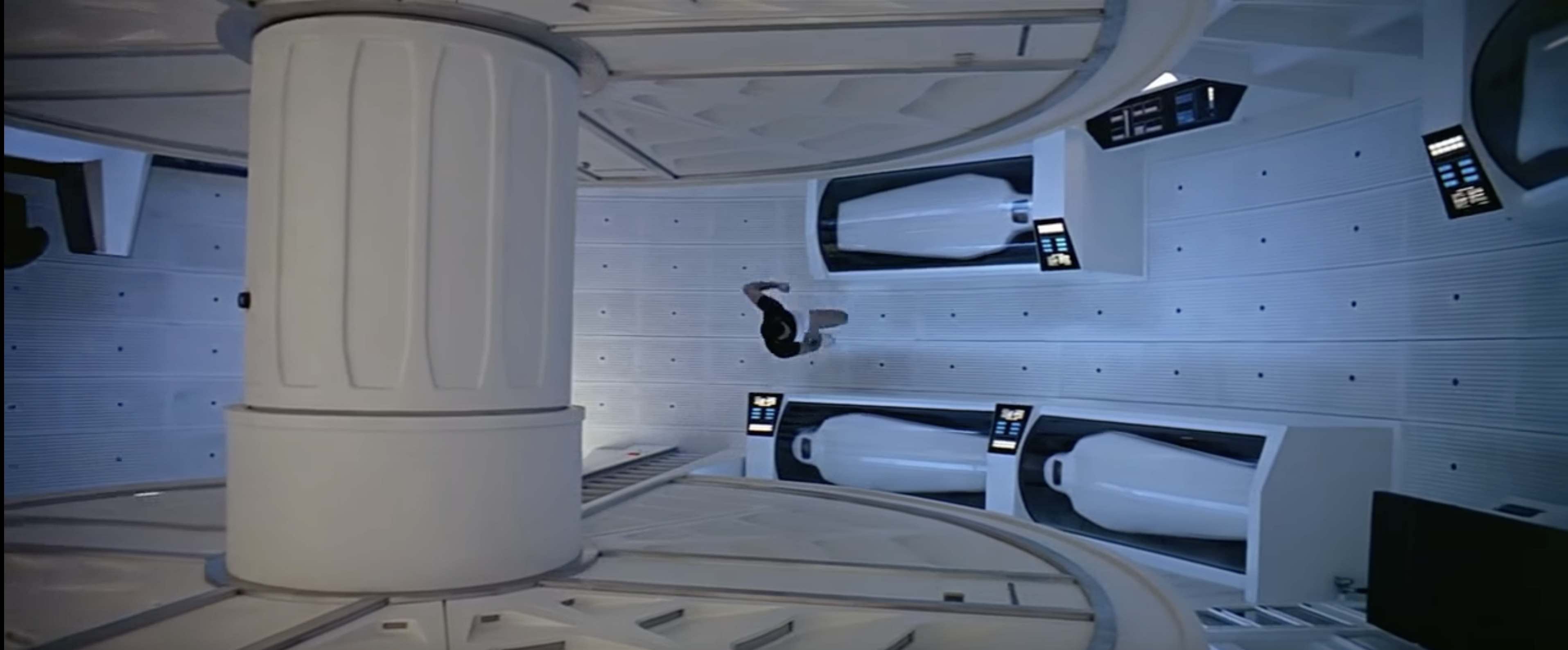Aram Khachaturian: Music from the Ballet "Gayne," Anatole Fistoulari, London Symphony Orchestra
AMAZING SOUND QUALITY FROM EVEREST RECORDS, 1959!
Aram Khachaturian's score for the ballet Gayne (or Gayane), which had its première in 1942, has had a lot more than its proverbial “15 Minutes of Fame.” It has enjoyed decades of fame, in fact.
In 1943 (despite the fact that there was a rather serious war going on), Khachaturian published three orchestral Suites from the ballet. The Suites have proven to be much more popular than the ballet itself. In truth, the full ballet is performed very infrequently. Perhaps the principal reason for the lack of performances is that the ballet’s choreography blends classical ballet with folk dances from several distinct cultures. Things like Armenian folk dances that call for unusual movements of the arms and hands.
If you want to see a brief (just over one minute) reel of highlights from a totally authentic, modern, very athletic—even acrobatic—performance of the ballet, watch this:
Composer James Horner used the Adagio from Khachaturian's Gayne Suite No. 3 in no fewer than three of his film soundtracks: Patriot Games; Clear and Present Danger; and Aliens. I wonder how many people caught onto that, back in the day.
However, the most famous film use of Gayne’s Adagio movement was Stanley Kubrick’s self-devised soundtrack for his 1968 science-fiction drama/spectacle 2001: A Space Odyssey. Khachaturian's Adagio’s bleakly pensive music is the perfect accompaniment to the dialog-free scene that introduces to us the Jupiter-bound spaceship Discovery and its taciturn crew. You can watch that scene below.
Strange, that. Or, at least, I think it is strange. While poor Alex North was slaving away at his new, from scratch 2001 score, Kubrick picked his own “Placeholder” music selections, which were originally assumed to be temporary. (North’s score for Kubrick’s previous hit film Spartacus was an important part of that film’s success, and the Spartacus soundtrack LP sold very well.)
North handed in his complete score, only to have Kubrick later reject it sub-silentio. Which is to say, North learned that Kubrick had permanentized his previously temporary music selections (thereby consigning North’s new work to the dustbin of history), only while North was seated in the audience at 2001’s New York VIP private screening. That must have been awkward. For at least one of them.
The reason I say that the selection of the Gayne Adagio for 2001 strikes me as strange, is that the one piece by Khachaturian that most people know, even if that knowledge came about only because it was what was playing in the background while some guy was spinning multiple dinner plates atop willow wands on the Ed Sullivan TV show, is the “Sabre Dance.” Which is also from Gayne.
Quick, name another piece by Khachaturian! The only one that comes to mind for me is his Violin Concerto, and that’s only because Oistrakh recorded it. On the other hand, Khachaturian started but did not finish a Harmonica Concerto. Let’s count our blessings!
So, I have to wonder, how did Kubrick know about the haunting, and I really do mean haunting Adagio from Gayne? 2001’s use of the Adagio from Gayne is often cited as one of the most impressive soundtrack choices in the entire history of cinema. What I can only wonder is… did Stanley Kubrick own a copy of the (recorded 1959, released 1960) Everest London Symphony Gayne LP? But, as per the norm, I am getting ahead of myself.
 “Gayne” is a girls’ name in Armenia. According to the original liner notes of this 1960 Everest release, the name is pronounced "Guy-neh," which makes me think of Gynecology.
“Gayne” is a girls’ name in Armenia. According to the original liner notes of this 1960 Everest release, the name is pronounced "Guy-neh," which makes me think of Gynecology.
In the story line of the 1942 ballet, poor Gayne is saddled with a wife-beating Nazi drunkard of a hubby. But she then falls in love with the virtuous, incorruptible commander of a Red Army border patrol. Right.
BTW, Hubby was not really an NSDAP member; “wife-beating Nazi drunkard” is just a stock phrase that I love. He was more like a small-time hoodlum, smuggler, and general ne'er-do-well.
Anyway, for reasons that need not concern anyone else apart from myself, I needed to find out which spelling of the girl's name was used in the original US 2001: A Space Odyssey Not-Really-Original Soundtrack LP.
Searching on QOBUZ, what do I find but a fastidious 24/192 Bernie Grundman digital transfer from Everest’s original three-channel 35mm magnetic-film masters of the 1959 Anatole Fistoulari/London Symphony recording of Fistoulari's selection of 11 movements chosen from all three of Khachaturian's Gayne Suites? That recording was made at Walthamstow Assembly Hall, London, November 1959. Bert Whyte produced, and Aaron Nathanson engineered.
 Walthamstow Assembly Hall, 1982 (photo by Michael Fremer)
Walthamstow Assembly Hall, 1982 (photo by Michael Fremer)
The original US Everest Records was founded in 1958 by electronics inventor Harry Belock, in Bayside, Long Island. (There is currently a totally unrelated Swiss record company using the same name.) Belock considered most of the music on offer on the new stereo LPs to be of unimpressive technical quality, and also lacking in musical significance. Belock threw a lot of money at those problems.
Belock and Bert Whyte decided that recording on 35mm magnetic film would provide greater dynamic range, lower print-through (because of the thicker stock), less tape stretch (ditto), and lower wow and flutter. Everest’s custom Westrex magnetic-film recorders cost $20,000 each, which is about $214,000 each in today’s money. Everest also plashed out for Neumann U 47 microphones.
Unfortunately, the buying public didn’t much care. Or, they didn't care enough. By 1961, Everest’s studio and all its recording equipment had been sold to engineer C. Robert Fine, who went on to use the equipment for famous projects of Mercury Records and other labels. The Wiki linked to above tells the Everest story in great detail.
Recording on 35mm magnetic film had two major technical advantages. First, and I think rather indisputably, 35mm media, all other things being equal, has about 300% the recording-surface area of half-inch magnetic tape, and 600% the recording area of quarter-inch magnetic tape. Everest also claimed that 35mm magnetic film’s “sprocket drive” (similar to motion-picture film) reduced wow and flutter to unprecedentedly low levels.
Reading the liner-note booklet for this Countdown Media digital remastering, I would be hard-pressed to see any possible areas for improvement. First of all, while some Everest 35mm film masters have been lost or are no longer usable, for this project, the original 35mm films were the sources.
Secondly, Bermie Grundman played the 35mm film masters back on a modified Westrex 1551 recorder, with new playback heads and new playback electronics. Digital conversion was at 24/192. The analog-to-digital converters are claimed to be “state of the art,” but other than that, they are not identified.
This recording is similar to the recently-reviewed 1970 Jerry Bruck recording of Jascha Horenstein's Mahler Third Symphony, in that it is a bit difficult to get one's head around the idea that these recordings are more than 50 (Bruck Mahler) and 60 (Everest Gayne) years old. They sound very fresh.
Furthermore, both the Bruck and Everest recordings are minimalist stereo recordings of large (British) orchestras. Bruck used a Schoeps stereo pair, whereas Everest used three Neumann (at the time, I believe they would have to have been tube microphones) U 47s. Whether Everest used an actual Decca Tree is something I have not been able to discover.
Is this a recording of music of earth-shaking importance? Nope. A lot of it is "Evening at the Pops" (or even, "lollipop") music. There are even times I am tempted to think, "This is the kind of earnest-but-clueless circus music that Shostakovich would ironically write parodies of."
So, I am not recommending that anyone buy all the download tracks. Unless you really really want them. Presto Music has the best prices I found, and downloading the famous Gayne Adagio in 24/912 will cost you all of two bucks. That, I most highly recommend. Buy it for the luscious string tone. And, I did mention that this remastering is up on QOBUZ in 24/192.
POSTSCRIPT
After sending this in, I discovered that Jascha Heifetz, at some time before 1960, made three violin-and-piano transcriptions from Gayne: "You-Know-What," "Ayesha's Dance" and... the Adagio!!!
Tant mieux, in 1960, Leonid Kogan recorded all three, and they are up on QOBUZ. I have started pulling some strings in an effort to get those Heifetz transcriptions published as sheet music.











































